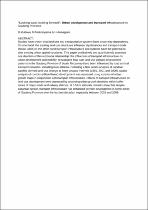 ResearchSpace
ResearchSpace
“Looking back, looking forward": urban development and transport infrastructure in Gauteng Province
JavaScript is disabled for your browser. Some features of this site may not work without it.
- ResearchSpace
- →
- Research Publications/Outputs
- →
- Conference Publications
- →
- View Item
| dc.contributor.author |
Mubiwa, B

|
|
| dc.contributor.author |
Mokonyama, Mathetha T

|
|
| dc.contributor.author |
Annegarn, H

|
|
| dc.date.accessioned | 2015-11-09T11:26:38Z | |
| dc.date.available | 2015-11-09T11:26:38Z | |
| dc.date.issued | 2015-07 | |
| dc.identifier.citation | Mubiwa, B., Mokonyama, M.T, and Annegarn, H. 2015. “Looking back, looking forward": urban development and transport infrastructure in Gauteng Province. In: 34th Southern African Transport Conference (SATC 2015), CSIR International Convention Centre, Pretoria, 7-9 July 2015, pp 801-812. | en_US |
| dc.identifier.uri | http://hdl.handle.net/10204/8247 | |
| dc.description | Abstract Only. | en_US |
| dc.description.abstract | Studies have shown that land-use and transportation systems have a two-way dependency. On one hand, the existing land-use structures influence trip distances and transport mode choice, while on the other hand transport infrastructure and systems have the potential to alter existing urban spatial structures. This paper qualitatively and quantitatively assesses one direction of this reciprocal relationship: the influences of transport infrastructure on urban development and mobility. It evaluates how past land-use (urban) development patterns in the Gauteng Province of South Africa may have been influenced by road and rail transport networks, including train stations. Following a time series analysis of Landsat satellite derived land-use change at three decadal intervals (1991, 2001 and 2009), spatial analysis of corridor (ribbon/linear) development was assessed using a series of urban growth maps in conjunction with transport infrastructure. Effects of transport infrastructure on land use development were assessed by analysing urban growth densities within buffer zones of major roads and railway stations, at 0.5 km intervals. Results show that despite suburban sprawl, transport infrastructure has enhanced corridor development in some areas of Gauteng Province over the last two decades, especially between 2001 and 2009. | en_US |
| dc.language.iso | en | en_US |
| dc.relation.ispartofseries | Worklist;15857 | |
| dc.subject | 34th Southern African Transport Conference 2015 | en_US |
| dc.subject | Transportation systems | en_US |
| dc.subject | Transport infrastructure | en_US |
| dc.subject | Landsat satellite | en_US |
| dc.title | “Looking back, looking forward": urban development and transport infrastructure in Gauteng Province | en_US |
| dc.type | Conference Presentation | en_US |
| dc.identifier.apacitation | Mubiwa, B., Mokonyama, M. T., & Annegarn, H. (2015). “Looking back, looking forward": urban development and transport infrastructure in Gauteng Province. http://hdl.handle.net/10204/8247 | en_ZA |
| dc.identifier.chicagocitation | Mubiwa, B, Mathetha T Mokonyama, and H Annegarn. "“Looking back, looking forward": urban development and transport infrastructure in Gauteng Province." (2015): http://hdl.handle.net/10204/8247 | en_ZA |
| dc.identifier.vancouvercitation | Mubiwa B, Mokonyama MT, Annegarn H, “Looking back, looking forward": urban development and transport infrastructure in Gauteng Province; 2015. http://hdl.handle.net/10204/8247 . | en_ZA |
| dc.identifier.ris | TY - Conference Presentation AU - Mubiwa, B AU - Mokonyama, Mathetha T AU - Annegarn, H AB - Studies have shown that land-use and transportation systems have a two-way dependency. On one hand, the existing land-use structures influence trip distances and transport mode choice, while on the other hand transport infrastructure and systems have the potential to alter existing urban spatial structures. This paper qualitatively and quantitatively assesses one direction of this reciprocal relationship: the influences of transport infrastructure on urban development and mobility. It evaluates how past land-use (urban) development patterns in the Gauteng Province of South Africa may have been influenced by road and rail transport networks, including train stations. Following a time series analysis of Landsat satellite derived land-use change at three decadal intervals (1991, 2001 and 2009), spatial analysis of corridor (ribbon/linear) development was assessed using a series of urban growth maps in conjunction with transport infrastructure. Effects of transport infrastructure on land use development were assessed by analysing urban growth densities within buffer zones of major roads and railway stations, at 0.5 km intervals. Results show that despite suburban sprawl, transport infrastructure has enhanced corridor development in some areas of Gauteng Province over the last two decades, especially between 2001 and 2009. DA - 2015-07 DB - ResearchSpace DP - CSIR KW - 34th Southern African Transport Conference 2015 KW - Transportation systems KW - Transport infrastructure KW - Landsat satellite LK - https://researchspace.csir.co.za PY - 2015 T1 - “Looking back, looking forward": urban development and transport infrastructure in Gauteng Province TI - “Looking back, looking forward": urban development and transport infrastructure in Gauteng Province UR - http://hdl.handle.net/10204/8247 ER - | en_ZA |





